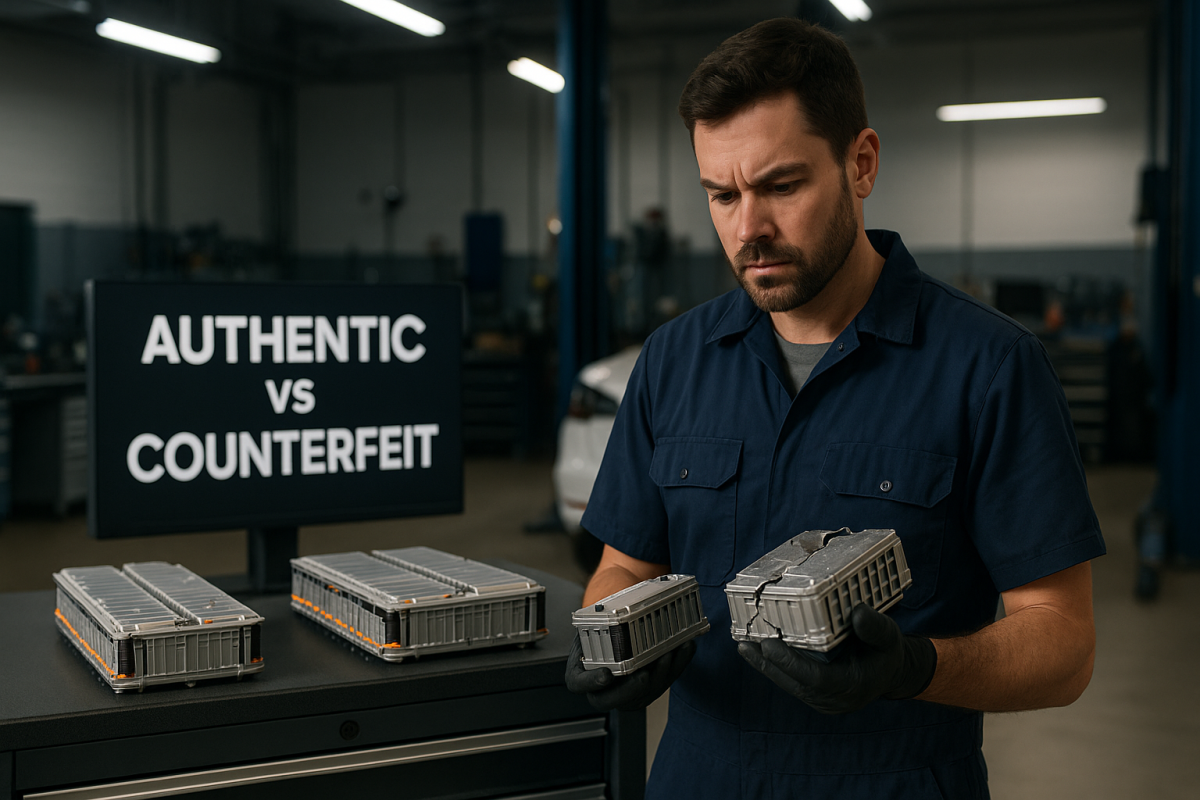In 2025, the second-hand electric vehicle (EV) market is booming—and so is a shadow industry of questionable and even deadly replacement parts. Online marketplaces like eBay have seen continuing increases in listings for “OEM Compatible” EV battery modules, many priced well below manufacturer-direct offerings. Electrifying.com notes a 58.5% increase in used battery electric car sales in Q1 2025 versus the previous year.
But as any experienced mechanic will tell you, today’s garage is increasingly a battleground between authentic engineering and a flood of dubious imports. And what you don’t want is a dubious import that causes a fire so hot that even the fire department can’t put it out.
A Costly Gamble for EV Owners
Let’s say the owner of an out-of-warranty Tesla Model Y, hoping to save money, takes their car to an independent garage. The shop sources a replacement battery module online, advertised as “authentic.” After installation, the vehicle runs fine—until a “check battery” warning appears after just 50 miles. The issue? Counterfeit EV battery modules—often assembled with mismatched cells and unstable firmware—are prone to early failures and ‘check battery’ warnings within a short distance after installation.

The Rise of Counterfeit EV Parts
Counterfeit battery modules and ECUs (Electronic Control Units) are a growing concern in the aftermarket repair ecosystem. Genuine Tesla battery modules, for instance, a Model 3 battery pack, can cost $20-28,000. On platforms like eBay and Alibaba, however, “OEM Compatible” modules have been seen for $1,200–$1,500, appealing to cost-conscious garages and DIY-ers alike. While some listings may involve refurbished OEM parts, many are knock-offs assembled with unvetted lithium-ion cells. Low-cost counterfeit batteries often use substandard cells lacking safety features (such as CID, a device that prevents those 1,000° C thermal runaway fires), poor assembly quality, and no assured firmware integrity.
The Fallout for Garages and Consumers
Independent garages, many of which operate on thin margins, are particularly vulnerable. Tempted by low prices and fast availability, some install these modules without realizing the hidden risks: shorted cells, BMS (battery management system) errors, or safety-critical software bugs. The consequences are predictable—failed repairs, unhappy customers, dangerous results, and reputational damage. Some garages now invest in battery module diagnostic tools and electronic authentication systems, but these technologies often cost upwards of a thousand dollars and require upskilling staff to use effectively. The authentication systems alone often require subscriptions or specialized hardware costing thousands. So, many garages just don’t.
Why the Problem Persists
This crisis persists largely because regulation has yet to catch up with the pace of EV adoption. Right-to-repair laws in many U.S. states remain narrow in scope, and proprietary software remains tightly controlled by OEMs. Tesla, for example, encrypts most of its BMS and drivetrain software, blocking third-party access without official licensing, and VIN-locks its part so you can only use new Tesla parts. Contravening both warranty and anti-trust laws, this imbalance limits the ability of independent garages to source and verify authentic parts, creating fertile ground for black-market sellers.

A Market at a Crossroads
As EVs age and warranties expire, the temptation to cut corners will grow, especially with Li-on battery prices as they are. Without urgent action to expand parts access, enforce marketplace accountability, and educate consumers, counterfeit components will increasingly undermine EV safety and reliability, at scale.
Until then, the best advice remains timeless: if a part’s price seems too good to be true, it probably is. In the whirlwind world of EV repairs, authenticity should not be a luxury. It’s a prerequisite for safety, performance, and peace of mind. Make sure your mechanic can guarantee authentic parts; stay involved.
The very best way to counter counterfeiters, of course, is make sure brands don’t do things like VIN-lock parts, or void warranties for using spare parts. Brands need to get on board, free up control, to push the counterfeiters out of business.
You can find more of Brian’s articles here. You can’t miss reading about Tesla’s Odometergate scandal – Tesla accused of winding back odometers to end warranties sooner – which could be bigger for Tesla than the EUR 30bn diesel emissions cheating was for VW.